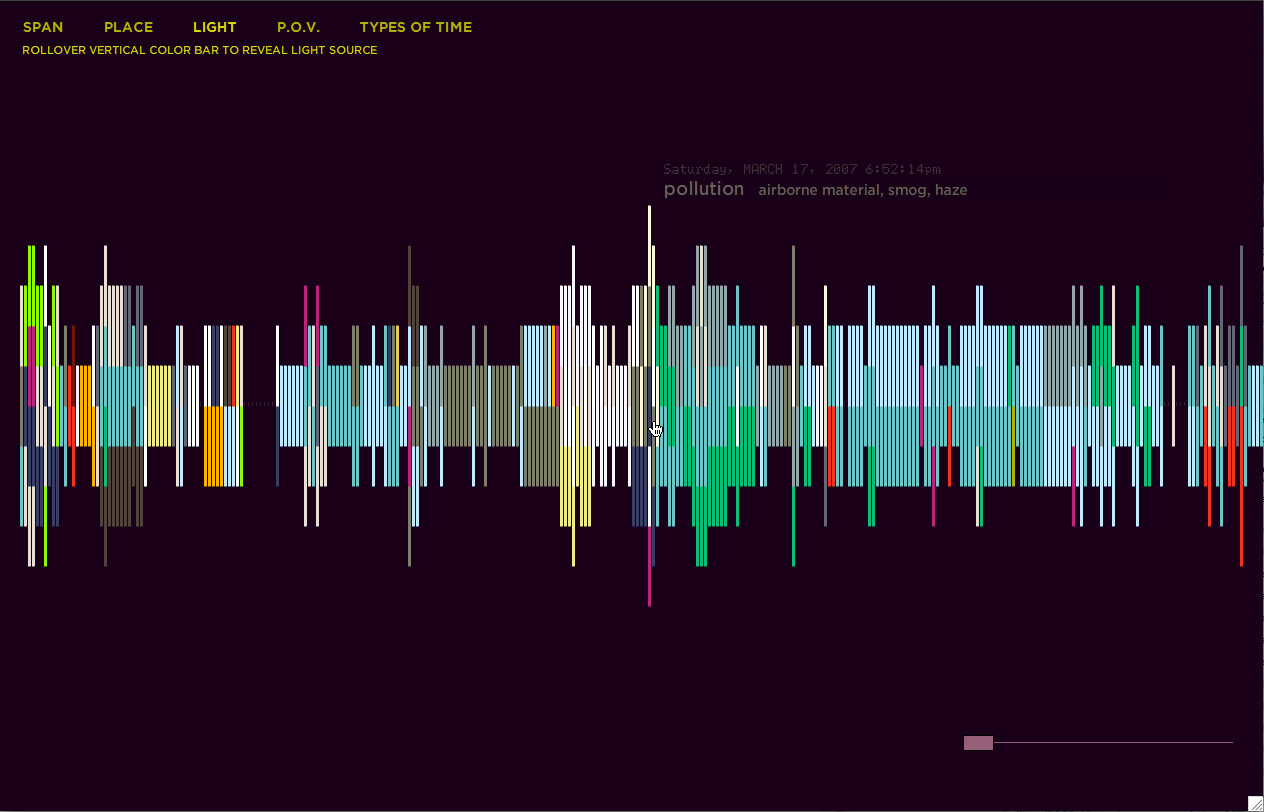shi jian: time
By Mark Hansen
Design by Raegan Kelly & Michelle Menzies
Creative Database Direction by
Michelle Menzies
As we will see, everything will come down to the indirect or mediated relation between consciousness and technics, which is equally to say, to the payoff of the fundamental transformation of media we have just been exploring
- Mark Hansen, Author's Statement
Alternative views of shi jian: time project data:
 All info and conversations from this project page
All info and conversations from this project page
http://vectors.usc.edu/xml/projects/shi_jian_v1.xml
 RSS feed of the conversations from this project page
RSS feed of the conversations from this project page
http://vectors.usc.edu/rss/project.rss.php?project=91
http://vectors.usc.edu/xml/projects/shi_jian_v1.xml
http://vectors.usc.edu/rss/project.rss.php?project=91
Project Credits
Mark Hansen
AuthorA bio hasn't been entered for Mark Hansen.
Raegan Kelly raegank@gmail.com
Designer ProgrammerCo-Creative Director and site designer for Vectors through the Difference issue (5), Raegan Kelly has worked as an interactive designer, programmer, cinematographer, and screen printer for the last 15 years. Raegan is leaving to focus her creative energies on a solo venture in innovative, functional and non- toxic material design. She has a BA from UC Berkeley and an MFA in Film from CalArts.
Michelle Menzies michelle.menzies@gmail.com
http://michellemenzies.com/
Creative Database DirectionMichelle is an artist who works with time-based media, particularly moving-image installation, video and photography. She is a doctoral candidate at the University of Chicago with research interests in film, poetry, critical theory and aesthetics. Her dissertation-in-progress, titled "Archives of Experience: Toward a Digital Aesthetics," argues a historical genealogy of movement for contemporary media aesthetics.
Craig Dietrich craig.dietrich@usc.edu | http://www.craigdietrich.com
Database & XML DevelopmentCraig teams with scholars and designers on Vectors projects solving creative and information challenges, and creates tools for online art & humanities production. His recent collaborations include the Mukurtu Archive and Plateau People's Web Portal content manager based on Aboriginal cultural protocols, ThoughtMesh, a semantic online publishing system, the Dynamic Backend Generator, a MySQL-based relational data writing canvas, and an upcoming metadata server for artworks and artists. He is presently in production of Magic, a project documenting innovation in humanities-centered interactive media, and USA Today, a multimedia project focusing on trans-nationalism's consequences. Craig is an Assistant Professor of Cinema Practice at USC's Institute for Multimedia Literacy, part of the School of Cinematic Arts, where he teaches project design and creative hypertext. He is also further immersed in network art and culture as a researcher at the University of Maine's Still Water lab.
Mark Hansen
AuthorA bio hasn't been entered for Mark Hansen.
Raegan Kelly raegank@gmail.com
Designer ProgrammerCo-Creative Director and site designer for Vectors through the Difference issue (5), Raegan Kelly has worked as an interactive designer, programmer, cinematographer, and screen printer for the last 15 years. Raegan is leaving to focus her creative energies on a solo venture in innovative, functional and non- toxic material design. She has a BA from UC Berkeley and an MFA in Film from CalArts.
Michelle Menzies michelle.menzies@gmail.com
http://michellemenzies.com/
Creative Database DirectionMichelle is an artist who works with time-based media, particularly moving-image installation, video and photography. She is a doctoral candidate at the University of Chicago with research interests in film, poetry, critical theory and aesthetics. Her dissertation-in-progress, titled "Archives of Experience: Toward a Digital Aesthetics," argues a historical genealogy of movement for contemporary media aesthetics.
Craig Dietrich craig.dietrich@usc.edu | http://www.craigdietrich.com
Database & XML DevelopmentCraig teams with scholars and designers on Vectors projects solving creative and information challenges, and creates tools for online art & humanities production. His recent collaborations include the Mukurtu Archive and Plateau People's Web Portal content manager based on Aboriginal cultural protocols, ThoughtMesh, a semantic online publishing system, the Dynamic Backend Generator, a MySQL-based relational data writing canvas, and an upcoming metadata server for artworks and artists. He is presently in production of Magic, a project documenting innovation in humanities-centered interactive media, and USA Today, a multimedia project focusing on trans-nationalism's consequences. Craig is an Assistant Professor of Cinema Practice at USC's Institute for Multimedia Literacy, part of the School of Cinematic Arts, where he teaches project design and creative hypertext. He is also further immersed in network art and culture as a researcher at the University of Maine's Still Water lab.


